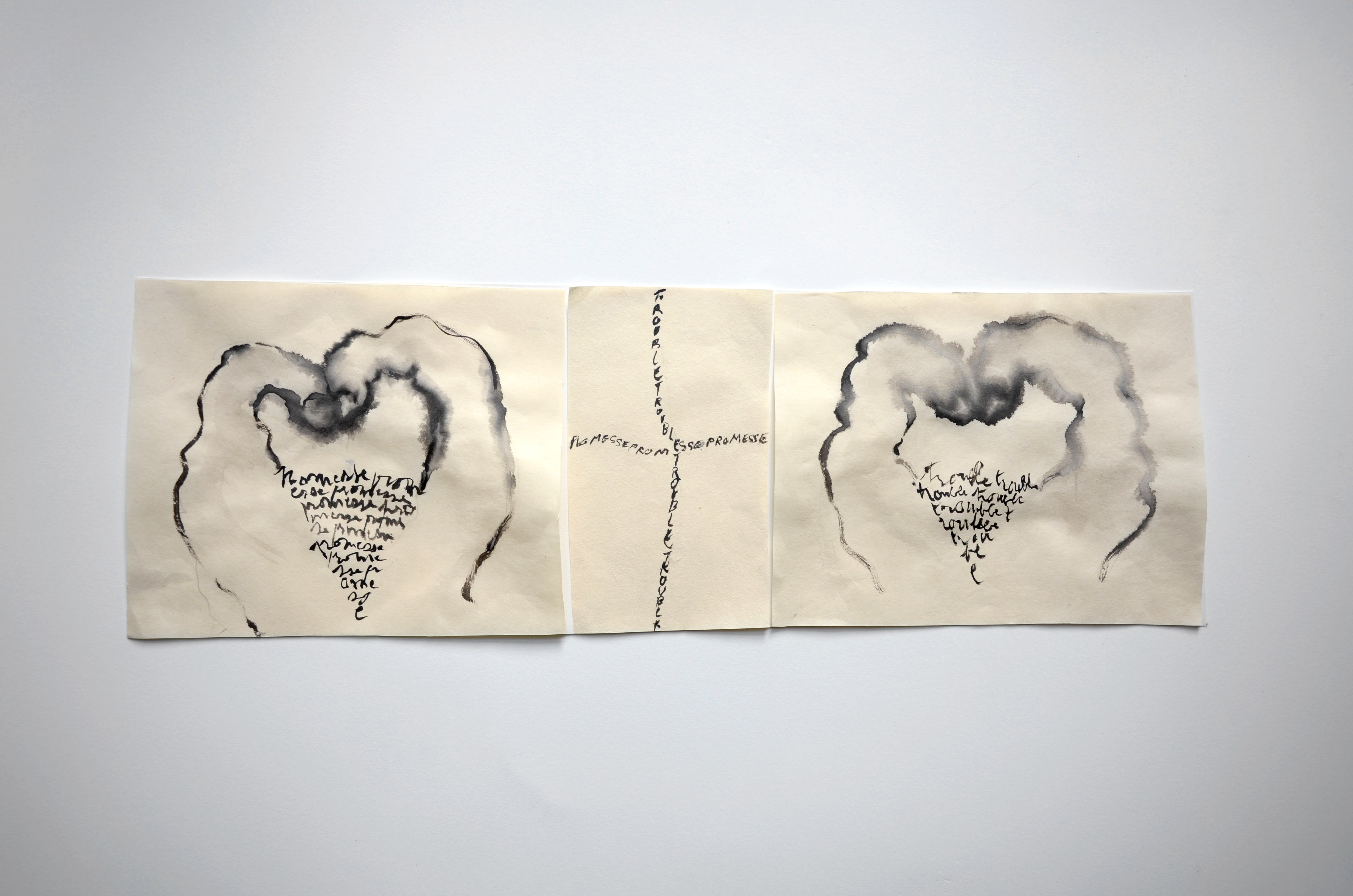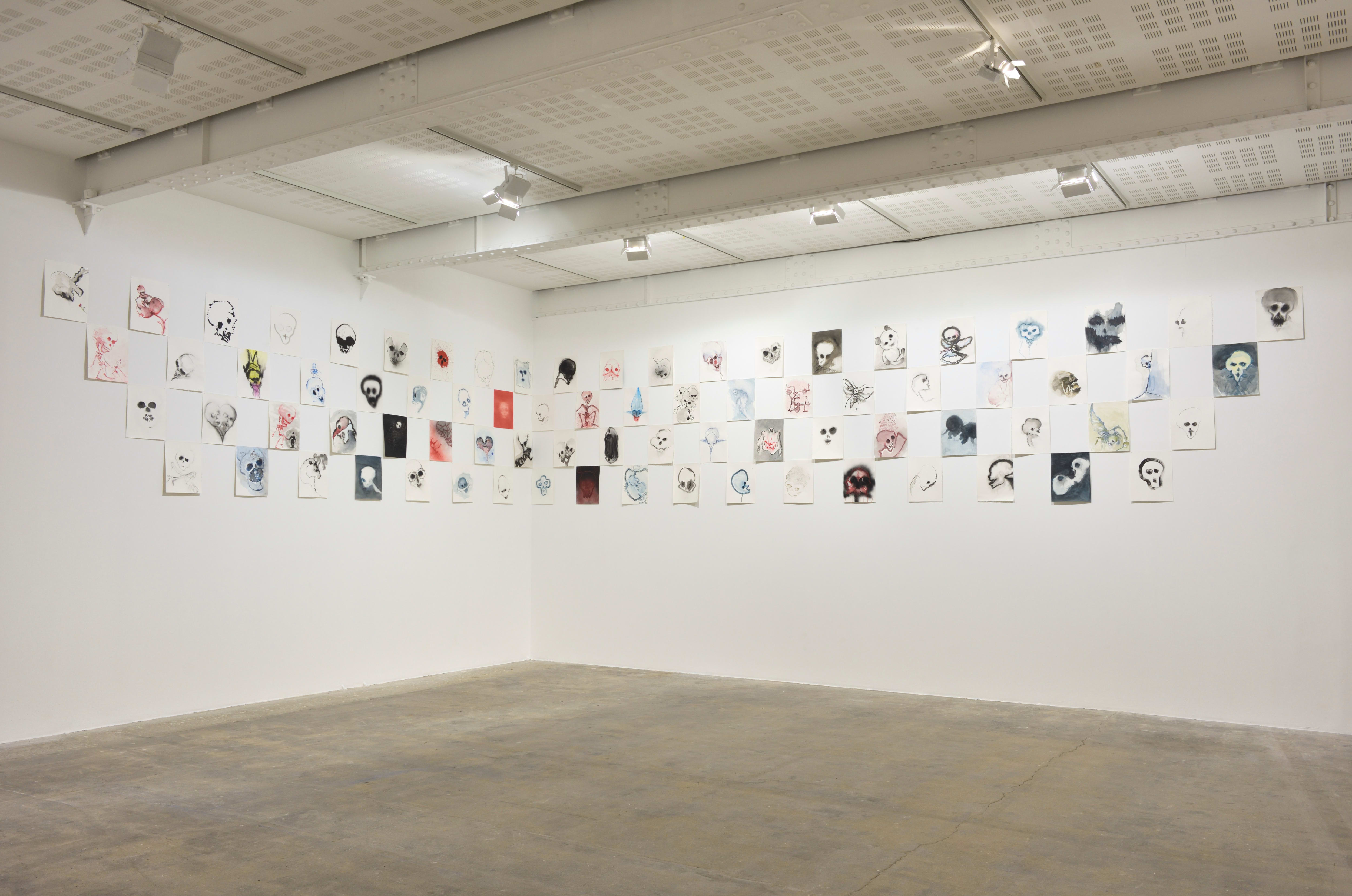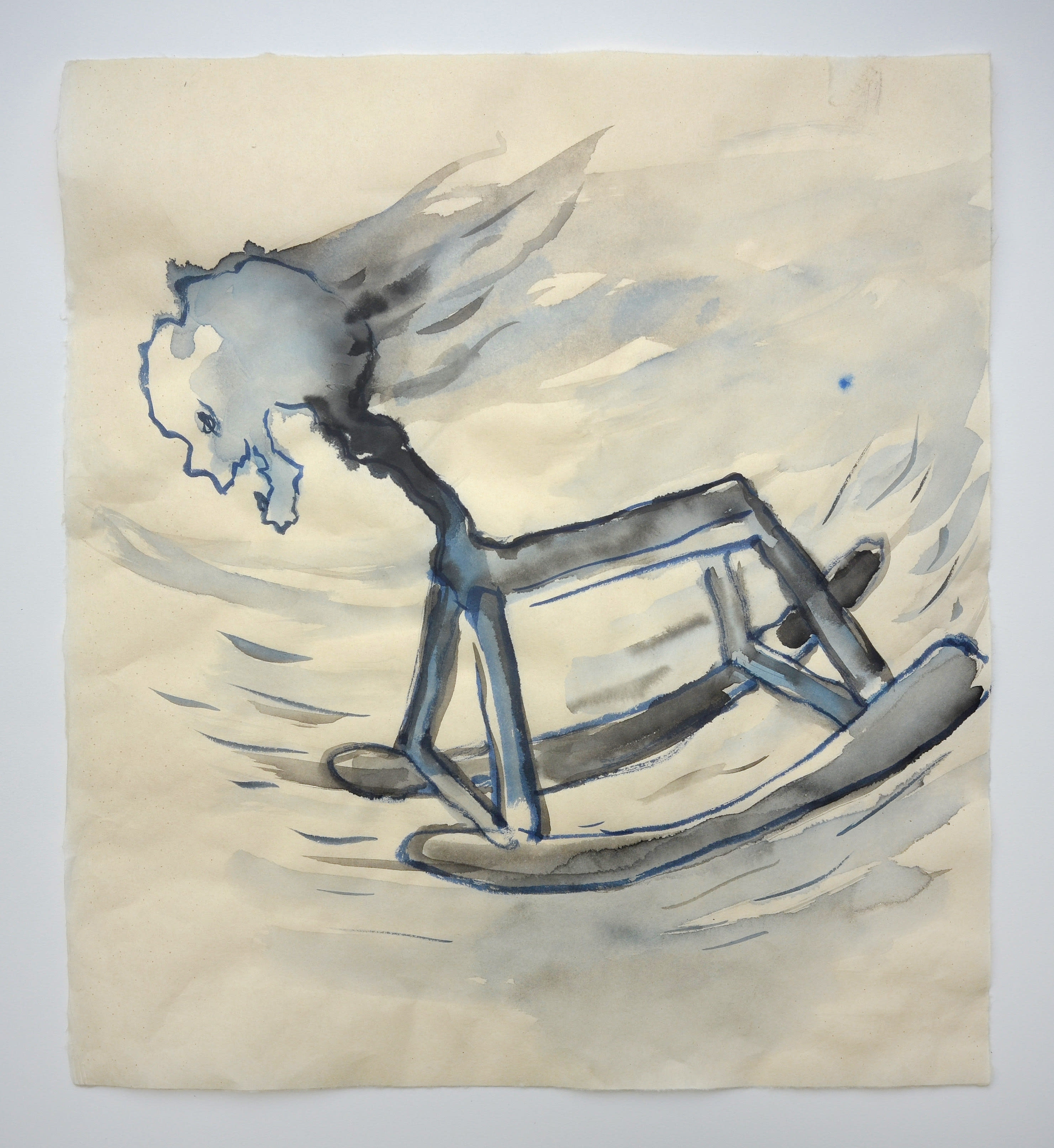Annette Messager: Laisser aller
Laisser aller
79 rue du Temple, Paris | 8 March - 11 May 2024
Marian Goodman Gallery is pleased to present a new exhibition by Annette Messager. At the Parisian gallery where she first exhibited in 2000, the artist offers a journey through her new production, emblematic of the polysemic and abundant work she has been unfolding since the early 1970s. For Messager, "playfulness is a way of telling the truth," and Laisser aller could be likened to a treasure hunt, in which the drawings, assemblages, words and sounds that make up her work are all clues to her universe. Inspired by her daily life and by the myriad of things she has lived, seen, read or heard, Messager's work speaks to us with mischievousness about childhood, love and death.
Over the past ten years, drawing has taken on a predominant role in the artist's work, enabling her to express herself freely, immediately and poetically. "My drawings are visual haikus," she asserts. Numerous drawings are displayed throughout the exhibition, interweaving with most of the works, including the 7-metre-long mural installation En même temps 2 (2021), which occupies the main wall on the first floor. The artist describes the piece as "a conversation between small, very hieratic, very upright effigies, small black sculptures, which figure us humans. They seem to be observing us, while large, narrow, elongated, very organic drawings play with representations of our bodies, our organs, our fantasies, infiltrating and circulating, seeming to disrupt the dignity of these little effigies, all at the same time." The vertical drawings in red, black and blue acrylic each convey a vertiginous fall, including motifs representative of the artist's repertoire such as hands, skulls with arms and legs, spectral figures, a girl-squelette in a tutu, a pair of scissors, shoes, or rarer ones like hopscotch or the organ of the heart.
Marian Goodman Gallery is pleased to present a new exhibition by Annette Messager. At the Parisian gallery where she first exhibited in 2000, the artist offers a journey through her new production, emblematic of the polysemic and abundant work she has been unfolding since the early 1970s. For Messager, “playfulness is a way of telling the truth,” and Laisser aller could be likened to a treasure hunt, in which the drawings, assemblages, words and sounds that make up her work are all clues to her universe. Inspired by her daily life and by the myriad of things she has lived, seen, read or heard, Messager's work speaks to us with mischievousness about childhood, love and death.
Over the past ten years, drawing has taken on a predominant role in the artist's work, enabling her to express herself freely, immediately and poetically. “My drawings are visual haikus,” she asserts. Numerous drawings are displayed throughout the exhibition, interweaving with most of the works, including the 7-metre-long mural installation En même temps 2 (2021), which occupies the main wall on the first floor. The artist describes the piece as “a conversation between small, very hieratic, very upright effigies, small black sculptures, which figure us humans. They seem to be observing us, while large, narrow, elongated, very organic drawings play with representations of our bodies, our organs, our fantasies, infiltrating and circulating, seeming to disrupt the dignity of these little effigies, all at the same time.” The vertical drawings in red, black and blue acrylic each convey a vertiginous fall, including motifs representative of the artist's repertoire such as hands, skulls with arms and legs, spectral figures, a girl-squelette in a tutu, a pair of scissors, shoes, or rarer ones like hopscotch or the organ of the heart.
Drawings also feature in the large-scale installation Laissons aller (2023), shown here for the first time. A couple entwined in a wisp of smoke overlooks small sculptures of loving embraces covered in black aluminum foil, a material shared by Promenade de l'escargot (2019), La Flânerie de l'escargot (2022) and Avec l'oiseau (2022).
“For me, drawing is a kind of wandering,” explains Annette Messager, who also draws her inspiration from popular culture. With Iconic (2023), she proposes a composition of drawings based on iconic photographs of 20th-century personalities such as Charlie Chaplin, Albert Einstein and Marilyn Monroe. These portraits, all part of our collective memory - such as the ubiquitous one of Che Guevara with his star-spangled beret, popularized by Andy Warhol - are caught in the artist's nets, reminiscent of the fascination they held for her when she was growing up in Berck-sur-Mer. The black fishing nets she has been transfiguring since the 1990s enclose and protect, and these legends find themselves captured for eternity.
“Drawing is a game,” adds Messager, who enjoys fusing images, words and symbols. In Hésitation (2023), the cross - once an instrument of torture and death, now a symbol of eternal life - is transformed into a human silhouette. A fragmented body (a hand, an eye, a mouth) intermingles with words (hesitation, oblivion, cunning, threat, comedy) copied over and over again. The handwriting of a single word, like a silent incantation or magic formula, traces the shapes of the drawing.
“My drawings always seem to me ghostly apparitions, with just a sheet of paper, emptiness, ink, water...and chance…” confides Messager, who transforms the gallery's lower level into colorful, grotesque catacombs with the monumental installation Tête à Tête (2019-2020), where skulls and skeletons move from joy to melancholy, from laughter to tears. A collection of seventy-seven allegories of the transience of existence, spontaneously made,without repentance. These vanitas are closer to representations of Mexican calaveras than still lifes as they come to life, smile or grimace, and disguise themselves as planets, clowns, butterflies or ghosts. Sometimes two vanitas share the same sheet of paper, holding hands and talking face-to-face. A few words recur: ‘moi toi’ and ‘à mon intime,’ reminding us that this stylistic exercise was created by Messager to ward off her own vulnerability.
On the neighboring wall, the motif of the cross takes shape in Un coup de dé (2022) and Le dé de la passion (2022), a pair of unfolded dice displayed like shedded skin. The dice, symbol of chance and randomness par excellence, also evokes the soldiers playing dice with Christ's tunic from the Gospel of John. One shows off a skeletal body with dismembered hands and tiny legs, while the other sports the instruments of Christ's passion, such as hammer and ladder, and, not without humor, Swiss army knife and saw.
A composition of drawings and small installations such as Ghost (2017) and Tuer le père (2022) complete the presentation, while the vaulted space houses the sound work Comme si (2022) and Le désir attrapé par le masque (2021). The title is a nod to Pablo Picasso's surrealist play "Le désir attrapé par la queue"; here, a pair of naturalized palmipeds, topped with heads of soft toys, perch on a suspended mirror, lit by a twirling bulb. Lastly, the artist’s voice speaks to visitors through Comme si, a phrase alluding to our inclination for pretense, murmured repeatedly like a litany, akin to the words she diligently reproduces on paper.

Born in Berk-sur-Mer in 1943, Annette Messager lives and works near Paris. She is the winner of the Praemium Imperiale in the sculpture category for her entire career (2016) and represented France at the 51st Venice Biennale, where she was awarded the Golden Lion (2005). A major solo exhibition, including a wide selection of works created from the 1980s to the present day, will open at the Power Station of Art (PSA) in Shanghai in July 2024.
Since her first solo show in 1973, Messager has exhibited worldwide, with major exhibitions in recent years at the ARoS Museum in Arhus, Denmark (2023); the LaM - Musée d'art moderne et contemporain de Lille Métropole (2022); Tel Aviv Museum of Art (2022); Centre Pompidou Metz (2021); Institut Giacometti in Paris (2018); Institut Valencià Art Modern (IVAM) in Valencia, Spain (2018); Villa Medicis in Rome (2017); Musée des Beaux-Arts and Cité de la Dentelle et de la Mode in Calais (2015-2016); Museum of Contemporary Art (MCA) in Sydney (2014); K21 in Düsseldorf (2014); Museo de Arte Contemporáneo de Monterrey (MARCO)(2011); The Hayward Gallery, London (2009); Museum of Modern Art (EMMA), Espoo (2008), National Museum of Contemporary Art, Seoul (2008), Mori Art Museum, Tokyo (2008); Musée National d'Art Moderne - Centre Pompidou, Paris (2007). Works by Messager are included in the collections of the world's leading museums: the Museum of Modern Art (MoMA) and Solomon R. Guggenheim Museum, New York; Musée national d'art moderne - Centre Pompidou, Paris and Musée d'art moderne de la Ville de Paris, Paris; Tate Modern, London; LACMA, Los Angeles; K21, Düsseldorf; The National Gallery, Canberra; San Francisco Museum of Modern Art; among others.





















